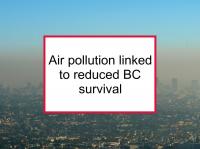A new study has reported that high levels of airborne particulates are associated with reduced breast cancer survival. The study was designed to investigate the long-term effects of ambient particulate matter on breast cancer survival. Ambient particulate matter consists of all the solid and liquid particles suspended in air at a given location.
It includes soot, smoke and other components of exhaust, as well as dust, pollen, and liquid droplets. Characteristics that are known to influence the health effects include the size of the particles, the presence of metals, PAHs, other organic components, or toxins.
California regulates two size classes of particle, measured in microns (one-millionth of a meter) - particles up to 10 microns (PM10) and particles up to 2.5 microns in size (PM2.5, a subset of PM10).
The study included 255,128 female breast cancer cases in the California Surveillance Epidemiology and End Results database. The authors linked these cases according to address to 1999-2009 county-level particulate matter daily monitoring data. The results were adjusted for individual variables such as demographic factors, breast cancer stage and year of diagnosis, as well as county-level factors such as socioeconomic status and access to medical resources.
Study results
Women with breast cancer living in areas with higher levels of PM2.5 and PM10 were found to have shorter survival than those living in areas with lower exposures. The greater the exposure to high PM2.5 or PM10, the higher the risk of early death. The authors also found that the deleterious effect of particulate matter on survival was more pronounced among women diagnosed with early stage disease.
The authors conclude that exposure to high levels of particulate matter may have adverse effects on the length of survival in women with breast cancer, particularly among those diagnosed with early stage breast cancer.
